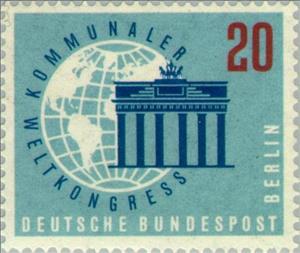Stamp: Globe, inscription, Brandenburg Gate (Berlin 1959)
Globe, inscription, Brandenburg Gate (Berlin 1959)
18 June (Berlin ) within release Municipal World Congress, Berlin goes into circulation Stamp Globe, inscription, Brandenburg Gate face value 20 German pfennig
| Stamp Globe, inscription, Brandenburg Gate in catalogues | |
|---|---|
| Michel: | Mi:DE-BE 189 |
| Yvert et Tellier: | Yt:DE-BE 168 |
Stamp is square format.
Stamp Globe, inscription, Brandenburg Gate it reflects the thematic directions:
Special Occasions
Cartography (/kɑːrˈtɒɡrəfi/; from Ancient Greek: χάρτης chartēs, 'papyrus, sheet of paper, map'; and γράφειν graphein, 'write') is the study and practice of making and using maps. Combining science, aesthetics and technique, cartography builds on the premise that reality (or an imagined reality) can be modeled in ways that communicate spatial information effectively.
A globe is a spherical model of Earth, of some other celestial body, or of the celestial sphere. Globes serve purposes similar to maps, but, unlike maps, they do not distort the surface that they portray except to scale it down. A model globe of Earth is called a terrestrial globe. A model globe of the celestial sphere is called a celestial globe
A building or edifice is a structure with a roof and walls standing more or less permanently in one place, such as a house or factory. Buildings come in a variety of sizes, shapes and functions, and have been adapted throughout history for a wide number of factors, from building materials available, to weather conditions, to land prices, ground conditions, specific uses and aesthetic reasons. Buildings serve several needs of society – primarily as shelter from weather, security, living space, privacy, to store belongings, and to comfortably live and work. A building as a shelter represents a physical division of the human habitat (a place of comfort and safety) and the outside (a place that at times may be harsh and harmful).




